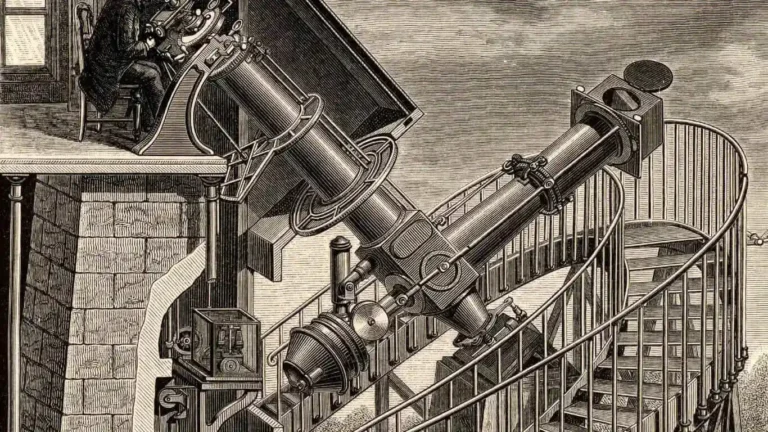Best Telescope For Beginners Under $200 – Top Picks
Are you an aspiring astronomer looking to explore the wonders of the night sky? Don’t worry about your budget, starting your stargazing journey can be affordable. This article will guide you through the top telescope picks for beginner astronomers, all under $200, ensuring you can pursue your passion without breaking the bank.
Our carefully curated list includes telescopes that provide outstanding views of celestial objects and are designed to be user-friendly. Whether you’re interested in observing the Moon, planets, or deep-sky objects like galaxies and nebulae, there’s a telescope here, so you can feel confident in your ability to operate it.
Discover each telescope’s features, specifications, pros, and cons to help you make an informed decision. From compact tabletop models to versatile telescopes with computerized mounts, we have options for various preferences and needs.
Bring out your inner astronomer and go on a cosmic adventure with these budget-friendly telescopes. Get ready to witness the brilliance of the cosmos from the comfort of your backyard. So, grab your telescope and journey into the vastness of space.
See Also:
- THE BEST TELESCOPES UNDER $500 – A TOP N LIST
- BEST TELESCOPES FOR ASTROPHOTOGRAPHY: JOURNEY INTO THE CELESTIAL WONDERS
- GSKYER TELESCOPE REVIEW – THE ULTIMATE CHOICE FOR STARGAZERS
Factors to Consider When Buying a Telescope
Before diving into the top telescope picks, one must understand the factors to consider when purchasing one. Here are a few key points to keep in mind:
- Aperture: The diameter of the telescope’s primary lens or mirror is known as the aperture. It establishes the quantity of light the telescope can collect, directly impacting the sharpness and luminosity of the observed objects. A bigger aperture offers superior views but also raises the expense and bulk of the telescope.
- Mount: Telescopes may be equipped with either an alt-azimuth or an equatorial mount. Alt-azimuth mounts are more straightforward and intuitive, making them well-suited for beginners. On the other hand, equatorial mounts are specifically designed to precisely track the movement of celestial objects, making them advantageous for astrophotography and advanced observations.
- Portability: Remember the size and weight of the telescope if you plan to transport it frequently. Compact and lightweight telescopes are more convenient for travel and outdoor use.
- Accessories: Look for telescopes with accessories like eyepieces, finderscopes, and tripods. These accessories can enhance your observing experience and provide convenience.
Top Telescope Picks for Beginner Astronomers
Let’s explore the top telescope picks for beginner astronomers under $200. These telescopes offer an outstanding balance between price, performance, and ease of use. There’s a telescope here for observing the Moon, Planets, or deep-sky objects such as galaxies and nebulae.
Celestron PowerSeeker 127EQ:
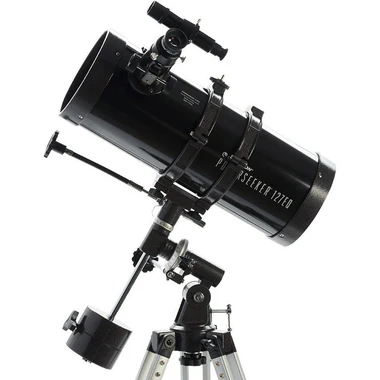
Celestron PowerSeeker 127EQ Telescope
Unveils the wonders of the night sky with this easy-to-use telescope. Great for beginners, it offers bright views of the Moon, planets, and celestial objects
This telescope features a 127mm aperture and comes with an equatorial mount. It provides sharp views of the Moon, planets, and even some brighter deep-sky objects. The included accessories, such as two eyepieces and a finderscope, make it a comprehensive package for beginners.
Specs
| Specification | Details |
| Optical Design | Newtonian Reflector |
| Aperture | 127 mm (5 inches) |
| Focal Length | 1000 mm |
| Focal Ratio | f/7.87 |
| Highest Useful Magnification | 300x |
| Lowest Useful Magnification | 18x |
| Limiting Stellar Magnitude | 13 |
| Mount Type | German Equatorial |
| Finderscope | 5×24 |
| Eyepieces Included | 20 mm (50x), 4 mm (250x) |
| Barlow Lens | 3x |
| Tripod | Adjustable, Aluminum |
| Weight | 21.4 lbs (9.7 kg) |
| User Level | Beginner to Intermediate |
PolarLink 80EQ Refractor Telescope
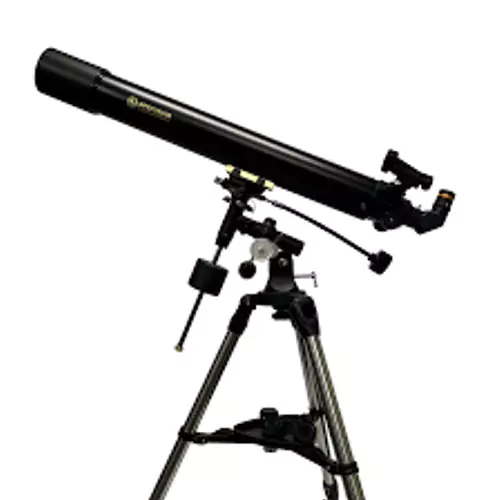
PolarLink 80EQ Refractor Telescope
Experience exceptional clarity with this refractor telescope. Ideal for astronomy enthusiasts, it delivers detailed views of the night sky.
The PolarLink 80EQ Refractor Telescope is perfect for beginners seeking a compact, portable option. Its intuitive equatorial mount allows users to easily track celestial objects, and the included eyepieces provide different magnification options for a versatile stargazing experience.
Specs
| Specification | Details |
| Optical Design | Refractor |
| Aperture | 80 mm (3.15 inches) |
| Focal Length | 900 mm |
| Focal Ratio | f/11.25 |
| Highest Useful Magnification | 160x |
| Lowest Useful Magnification | 11x |
| Limiting Stellar Magnitude | 12 |
| Mount Type | German Equatorial |
| Finderscope | 6×30 |
| Eyepieces Included | 25 mm (36x), 10 mm (90x) |
| Barlow Lens | 2x |
| Tripod | Adjustable, Aluminum |
| Weight | 18 lbs (8.16 kg) |
| User Level | Beginner to Intermediate |
Gskyer Telescope, 70mm Aperture
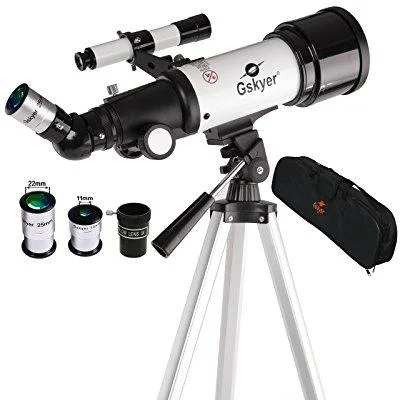
Gskyer Telescope, 70mm Aperture
perfect starter telescope for curious minds. This portable telescope offers a glimpse of the Moon, planets, and celestial wonders.
Thanks to its 70 mm aperture, the Gskyer Telescope is an ideal option for beginners seeking a compact and portable telescope. Its easy-to-use alt-azimuth mount allows for simple maneuvering, and the included eyepieces offer various magnification options. This makes it an excellent tool for exploring the expansive night sky.
Specs
| Specification | Details |
| Optical Design | Refractor |
| Aperture | 70 mm (2.75 inches) |
| Focal Length | 400 mm |
| Focal Ratio | f/5.7 |
| Highest Useful Magnification | 120x |
| Lowest Useful Magnification | 10x |
| Limiting Stellar Magnitude | 11 |
| Mount Type | Altazimuth |
| Finderscope | 5×24 |
| Eyepieces Included | 25 mm (16x), 10 mm (40x) |
| Barlow Lens | 3x |
| Tripod | Adjustable, Aluminum |
| Weight | 6.2 lbs (2.81 kg) |
| User Level | Beginner |
Telescope Features to Look For
When choosing a telescope, it’s helpful to understand the different features that can enhance your stargazing experience. Here are a few key features to look for:
- Go-To Functionality: Some telescopes have computerized mounts that can automatically locate celestial objects for you. This feature, known as Go-To functionality, is beneficial for beginners who may struggle to find objects in the night sky manually.
- Erect Image Optics: Most telescopes produce an inverted image, which can be challenging for beginners. Telescopes with erect image optics correct the image orientation, making navigating and observing objects easier.
- Collapsible Design: If you have limited storage space or frequently travel with your telescope, consider a model with a collapsible design. These telescopes can be easily disassembled and stored in a compact form, making them convenient for transportation.
- Slow Motion Controls: Telescopes equipped with slow motion controls allow for precise tracking and adjustment of the telescope’s position. This feature is handy when observing moving objects or tracking celestial events.
Understanding Telescope Specifications
Telescope specifications can sometimes be confusing for beginners. However, understanding these specifications will help you decide when purchasing a telescope. Here are a few standard specifications to consider:
- Aperture: As mentioned earlier, the aperture determines the telescope’s light-gathering capability. The measurement is typically expressed in millimeters (mm) or inches. (“). A larger aperture allows for brighter and more detailed views.
- Focal Length: The space between the telescope’s primary lens or mirror and the point where the light converges is known as the focal length. It affects the telescope’s magnification and field of view. Extended focal lengths result in higher magnification but narrower fields of view.
- Focal Ratio: The focal ratio is calculated by dividing the focal length by the aperture. It is represented by an “f/” followed by a number (e.g., f/5, f/10). A lower focal ratio indicates a broader field of view, while a higher focal ratio provides higher magnification.
- Magnification: A telescope’s magnification is determined by the combination of the eyepiece used and the telescope’s focal length. It is calculated by dividing the telescope’s focal length by the eyepiece’s focal length.
Telescope Accessories for a Better Stargazing Experience
While a telescope is the primary tool for stargazing, several accessories can enhance your observing experience. Here are a few accessories worth considering:
- Eyepieces: Eyepieces come in various focal lengths and determine the telescope’s magnification. A selection of eyepieces allows you to adjust the magnification based on your observing needs.
- Barlow Lens: A Barlow lens is a valuable accessory that increases the magnification of your telescope. It is inserted between the telescope and the eyepiece, doubling or tripling the magnification.
- Filters: Filters can enhance the visibility of specific features or objects. For example, a Moon filter can reduce the brightness of the Moon, allowing for better contrast and details.
- Red LED Flashlight: A red LED flashlight is essential for preserving your night vision while using the telescope. Unlike white light, red light has a minimal impact on your eyes’ dark adaptation.
Budget-Friendly Options for Beginner Astronomers
If you’re on a tight budget, there are still excellent options available for beginner astronomers. Here are a few budget-friendly telescopes worth considering:
Celestron PowerSeeker 70AZ
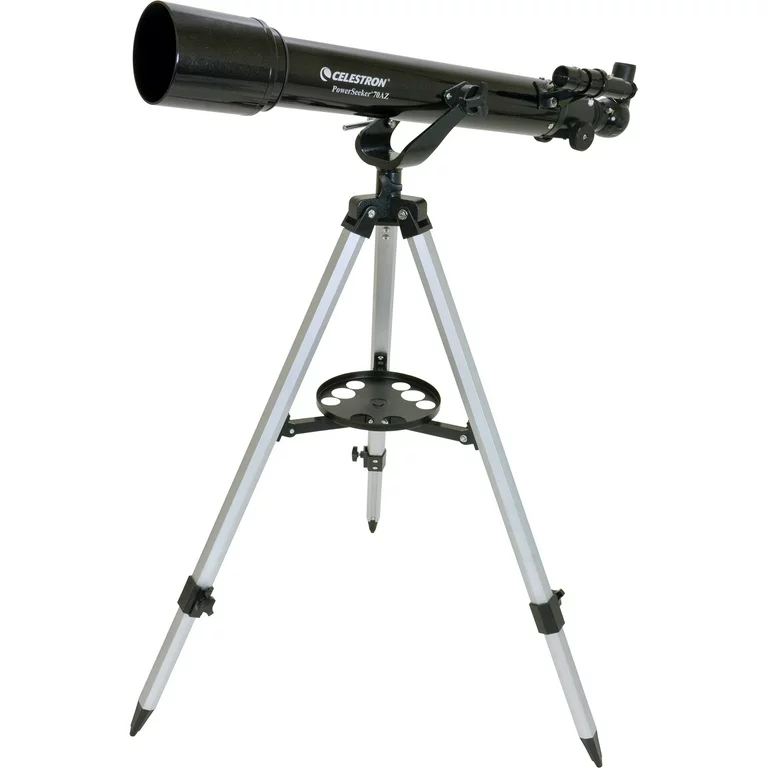
Celestron PowerSeeker 70AZ
Easy to set up and use, this telescope is ideal for quick observations of the Moon, planets, and brighter celestial objects.
The Celestron PowerSeeker 70AZ is perfect for beginners seeking a compact, portable option. Its intuitive alt-azimuth mount allows easy maneuvering, and the included eyepieces offer various magnification options, making it an ideal choice for beginner astronomers.
Specs
| Optical Design | Refractor |
| Aperture | 70 mm (2.76 inches) |
| Focal Length | 700 mm |
| Focal Ratio | f/10 |
| Highest Useful Magnification | 165x |
| Lowest Useful Magnification | 10x |
| Limiting Stellar Magnitude | 11.7 |
| Mount Type | Altazimuth |
| Finderscope | 5×24 |
| Eyepieces Included | 20 mm (35x), 4 mm (175x) |
| Barlow Lens | 3x |
| Tripod | Adjustable, Aluminum |
| Weight | 7 lbs (3.18 kg) |
| User Level | Beginner |
16X-200X High Power Telescope
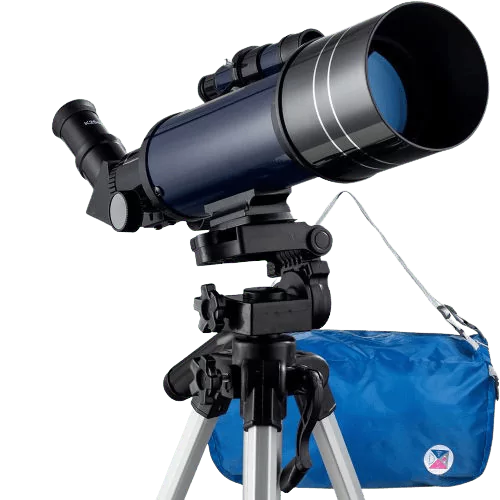
16X-200X High Power Telescope
Explore the depths of space with this high-power telescope.
The 16X-200X High Power Telescope is ideal for beginners looking for a compact and portable option. Its user-friendly alt-azimuth mount ensures easy maneuverability, and the included eyepieces offer a range of magnifications, enabling a versatile and enjoyable stargazing experience.
Specs
| Specification | Details |
| Optical Design | Refractor |
| Aperture | 70 mm (2.76 inches) |
| Focal Length | 400 mm |
| Focal Ratio | f/5.7 |
| Highest Useful Magnification | 200x |
| Lowest Useful Magnification | 16x |
| Limiting Stellar Magnitude | 11 |
| Mount Type | Altazimuth |
| Finderscope | Red Dot |
| Eyepieces Included | 20 mm (20x), 6 mm (67x) |
| Barlow Lens | 3x |
| Tripod | Adjustable, Aluminum |
| Weight | 5 lbs (2.27 kg) |
| User Level | Beginner |
Celestron – 70mm Travel Scope
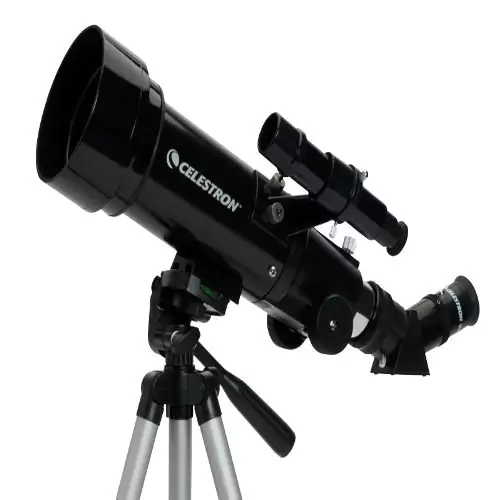
Celestron – 70mm Travel Scope
Perfect for stargazing on the go, this compact telescope is easy to transport and ideal for travel.
The Celestron 70mm Travel Scope is perfect for beginners seeking a compact, portable option. Its intuitive alt-azimuth mount allows for easy maneuvering, and the included eyepieces provide various magnification choices, making it an excellent tool for those new to astronomy.
Specs
| Specification | Details |
| Optical Design | Refractor |
| Aperture | 70 mm (2.76 inches) |
| Focal Length | 400 mm |
| Focal Ratio | f/5.7 |
| Highest Useful Magnification | 165x |
| Lowest Useful Magnification | 10x |
| Limiting Stellar Magnitude | 11.7 |
| Mount Type | Altazimuth |
| Finderscope | 5×24 |
| Eyepieces Included | 20 mm (20x), 10 mm (40x) |
| Barlow Lens | N/A |
| Tripod | Adjustable, Aluminum |
| Weight | 3.3 lbs (1.5 kg) |
| User Level | Beginner |
Tips for Using and Maintaining Your Telescope
To get the most out of your telescope and ensure its longevity, here are some tips for using and maintaining it:
- Read the Manual: Familiarize yourself with the telescope’s manual and instructions. Understanding how to set up and use the telescope properly will save you time and frustration.
- Align and Calibrate: If your telescope has a computerized mount, align and calibrate it properly. This will ensure accurate tracking and object location.
- Store Properly: Store your telescope in a dry, dust-free environment when not in use. Consider using protective cases or covers to prevent any damage or scratches.
- Clean with Caution: If your telescope’s optics require cleaning, do so cautiously. Follow the manufacturer’s recommendations and use appropriate cleaning tools to avoid damaging the delicate coatings.
Conclusion
Taking on an astronomy journey can be a thrilling and rewarding experience. With a wide range of top telescope picks for beginner astronomers under $200, you can delve into the mysteries of the night sky without straining your budget. Consider the features, specifications, and accessories that best suit your observing needs, and prepare to witness the magnificence of the cosmos from the comfort of your backyard. So, seize your telescope and venture into the vastness of space. Enjoy your stargazing adventure!
faqs
Can I get a good quality telescope for under $200?
Yes! Many entry-level telescopes offer great views of the Moon, planets, and bright stars within this budget. You just need to choose the right type and brand.
Which type of telescope is best for beginners on a budget?
A refractor or a tabletop Dobsonian reflector is ideal. Refractors are low-maintenance, while Dobsonians give you more aperture and brighter images for the price.
What features should I look for in a budget telescope?
Look for a stable mount, at least 70mm aperture, and quality optics. Easy assembly and included accessories like a red dot finder or Barlow lens are also a plus.
Can I see planets with a $200 telescope?
Absolutely. You can see the Moon’s craters, Saturn’s rings, Jupiter’s moons, and Mars as a red dot. The views are clear, especially with good eyepieces and steady skies.
Is it better to start with a manual or GoTo mount at this price?
Manual mounts are better for beginners under $200. They’re simple to use, teach you the sky, and keep the cost low without sacrificing quality.






